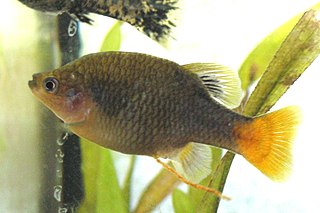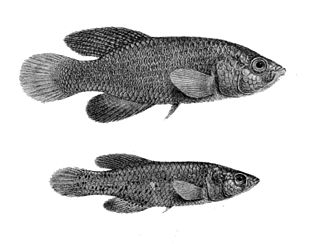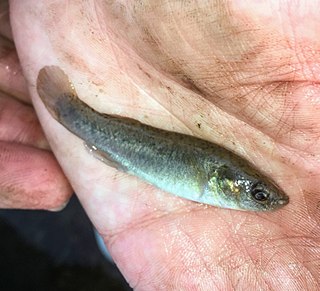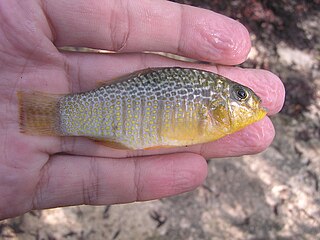
Goodeidae is a family of teleost fish endemic to Mexico and some areas of the United States. Many species are known as splitfins. This family contains about 50 species within 18 genera. The family is named after ichthyologist George Brown Goode (1851-1896).

The Ash Meadows killifish is a species of killifish from the subfamily Empetrichthyinae, part of the family Goodeidae, which was first documented by C. H. Gilbert in 1893 and historically occupied numerous springs near Ash Meadows, Nye County, Nevada, United States. This species was last seen in 1948 and is believed to have gone extinct in the early 1950s, likely as a result of habitat alteration and competition with and predation by introduced crayfish Procambarus clarkii, mosquitofish, black mollies, and bullfrogs.
The Parras characodon is a species of goodeid fish once endemic to Coahuila, Mexico. Its natural habitats were destroyed between 1900 and 1953, and no records have been made in the last century; it is considered extinct, although the validity of this taxon and where the actual type locality is are subject to some doubt. The specific name honours the American herpetologist and ichthyologist Samuel Garman (1843–1927).
The redtail notho is a species of killifish in the family Nothobranchiidae. It is endemic to Zanzibar. Its natural habitats are intermittent rivers and intermittent freshwater marshes. The redtail notho eats mosquito larvae and other planktonic creatures. Scientists are looking at introducing the species elsewhere in Africa to help with malaria prevention.

Nothobranchius korthausae is a species of killifish in the family Nothobranchiidae. It is endemic to Mafia Island in Tanzania. Its natural habitat is pools, ditches and small streams. The specific name of this species honours the German aquarist Edith Korthaus who collected the type.

The spotted killifish is a small, short lived species of fish, an African rivuline from the family Nothobranchiidae. These fish are native to many isolated freshwater pools located in the savannah depressions of east Africa, specifically Malawi, Mozambique, Zimbabwe, and South Africa. This species of fish occurs in ephemeral waters and killifish eggs can survive long periods of dehydration. The word killifish likely comes from the Dutch kil for kill.

The saltmarsh topminnow is a species of killifish for the family Fundulidae. It occurs in the coastal wetlands of the Gulf of Mexico in the United States.

Profundulus is a genus of fish in the family Profundulidae endemic to Mexico and northern Central America. It was regarded as the only genus in the Profundulidae but workers have split the genus and raised a second genus Tlaloc.

Cubanichthys is a small genus of pupfishes endemic to the Caribbean Islands of Cuba and Jamaica. The name of this genus is a compound of Cuba, where the genus was thought to be endemic until C. pengellyi was placed in the genus, and the Greek word for fish, ichthys.

Floridichthys is a genus of pupfishes native to the southeastern United States, Mexico and northern Central America. The name of this genus is a compound of Florida and the Greek for "fish", ichthys. The ichthyologist Carl Leavitt Hubbs thought that the genus was confined to Florida at the time he coined the name.
The Mexican rivulus is a species of killifish from the family Rivulidae which is endemic to Mexico where it is found in the Papaloapan and Coatzacoalcos River basins. This annual killifish grows to a total length of 4 cm (1.6 in). It is the only known species in its genus, but its exact taxonomic position remains uncertain, as it has not been included in any phylogenetic study. This species was described by Robert Rush Miller and Carl Leavitt Hubbs as Rivulus robustus in 1974, it was reclassified in the monotypic genus Millerichthys in 1995, the generic name honouring Robert Rush Miller.

Aphanius danfordii, the Kızılırmak toothcarp or Sultan Sazlığı toothcarp, is a species of killifish belonging to the family Cyprinodontidae. It is endemic to the Kızılırmak River and the upper Seyhan River drainage systems and is now restricted to a few locations in the Sultan Sazlığı marshes. Though little data is available, the population of the fish seems to be declining. The International Union for Conservation of Nature has rated its conservation status as being "critically endangered" and fears it may become extinct in the wild if the drainage of the marshes continues.

Lucania goodei, the bluefin killifish, is a small species of fish in the topminnow family Fundulidae. It is native to the southeastern United States, but has been introduced to California, Texas and North Carolina. Other common names for the fish include Florida blue dace.

Mucurilebias leitaoi is a species of rivulid killifish endemic to Brazil where it occurs, or formerly occurred, in the basin of the Mucuri River. This species can reach a length of 3 centimetres (1.2 in) TL. This species has not been seen since the original series of types was collected in 1988 and it may have become extinct due to the extensive habitat loss in the region. This species is the only known member of its genus, but it was formerly included in Leptolebias. The specific name of this fish honours the Brazilian ichthyologist and herpetologist Antenor Leitão de Carvalho (1910-1985).
The Dead Sea toothcarp is a subspecies of the Arabian toothcarp that is endemic to the Dead Sea basin, although molecular evidence suggests that it should be regarded as a species. It is threatened by water fluctuation, and the introduction of cichlids and Gambusia. The sub-specific name of this fish honours the Scottish surgeon and naturalist John Richardson (naturalist) (1787-1865) who first reported killifish in the Dead Sea basin. The Dead Sea toothcarp -- has been on the red list of the International Union for Conversation of Nature since 2014.

Fundulus luciae, the spotfin killifish, is a member of the genus Fundulus. This hardy fish is notable for spending its entire life in sporadically flooded salt marsh habitat, sheltering in shallow pools, puddles, and small tidal rivulets. It closely resembles the mummichog in shape and coloration, but the two species can be distinguished by dorsal fin ray count: 8–9 in the spotfin versus 11–12 in the mummichog. Additionally, the dorsal fin of F. luciae originates farther back, and slightly behind the anal fin origin; in the mummichog, the dorsal fin begins anteriorly to the anal fin origin. The spotfin killifish is named for the pronounced ocellus found on the posterior dorsal fin of adult males. It is a small fish, seldom attaining 50 millimetres (2.0 in) in total length. Its distribution extends along the U.S. east coast from Massachusetts to Georgia.

Tlaloc is a genus of fish in the family Profundulidae endemic to Mexico, Guatemala and Honduras. The genus is not, however, recognised by Fishbase or in the 5th Edition of Fishes of the World. The genus is named for Tlaloc the water god of the Aztecs.

The Seminole killifish is a fish of the genus Fundulus, endemic to the U.S. state of Florida.
Pachypanchax patriciae is a species of killifish from the family Aplocheilidae. It is endemic to Madagascar where it occurs in the basins of the Mananjeba, Mahavavy du Nord, Ifasy, Manehoko, and Ampandra rivers in the north west of the island. The specific name of this fish honours the Malagasy conservationist Patricia Yazgi (1946-2006), who ran the charity Friends of Fishes and who supported efforts to document and conserve the freshwater fish fauna of Madagascar. This species appears to feed mainly the adults and nymphs of terrestrial insects and on the larvae of aquatic insects and its most important predators are fish-eating birds and dragonfly nymphs. It may, however, be threatened by introduced alien fishes in some areas.
Cubanichthys pengelleyi, the Jamaican killifish, is a species of killifish from the family Cyprinodontidae, the pupfishes, which is endemic to Jamaica. It is found in shallow, crystal clear waters with a depth of 1.5 metres (4.9 ft) and a pH of 8.2). These have a substrate consisting mainly of sand with some softer patches of silt. This species hides among aquatic vegetation. Its prey consists of damselfly and dragonfly larvae, the larvae of other aquatic insects, ostracods, copepods and snails. The specific name honours the Jamaican physician and medical officer Charles Edward Pengelley (1888–1966) who obtained the type.















